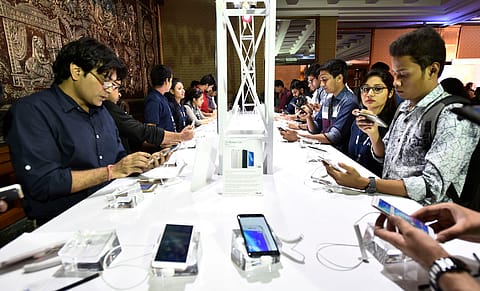Smartphone industry records sluggish 2% growth in Jan-March
Xiaomi records a 24% dip in shipments on a YoY basis, while Samsung sees a 2% degrowth. Bucking the trend, Realme records 40% annual growth at 6 million shipments.

India's smartphone industry shipped 38 million smartphones in the January-March quarter, recording just 2% growth on a year-on-year basis. This is one of the lowest YoY growth in quarterly smartphone shipments, which is being attributed to the spread of Omicron BA.2 variant of Covid-19, plus macroeconomic issues due to the Russia-Ukraine war, says a note by research firm Canalys.
Industry leader Xiaomi held the first position at 8 million shipments in the Jan-March period, despite another quarter of sequential decline. The company recorded a 24% dip in shipments on a YoY basis. Xiaomi's market share also plunged to 21% in Q1 2022 from 28% during the same quarter last year.
Samsung came second with 6.9 million units, recording a 2% degrowth in the said quarter. Its market share also dipped to 18% from 19% during the same quarter last year.
Of all top smartphone companies operating in India, Realme emerged as a real winner, recording 40% annual growth at 6 million shipments. Its market share increased to 16% from 12% during the same period last year.
Vivo and OPPO completed the top five with 5.7 million and 4.6 million units shipped, respectively.
The current slow-growth has surprised many because the industry had recorded double-digit growth even during the pandemic period. “This is not a great start to the year for a market like India, which has seen double-digit percentage growth even during the pandemic,” says Canalys analyst Sanyam Chaurasia.
As per Chaurasia, there was relatively a weaker impact on India's industry during the third Covid-19 wave in Q1 compared to other big markets. "But the supply remained the biggest challenge for the leading vendors, such as Xiaomi and Vivo, and they struggled to secure components for their volume-driving low-end models," he adds. In contrast, Realme, Tecno and Itel did well with solid supply to take on the market leaders and fulfil the low-end demand in Q1, he says.
Recommended Stories
Companies are now pinning hopes on Q2. A positive uptick is expected as vendors have taken some steps to address the supply bottlenecks. Sell-in already started to improve in March, and the companies are aiming for a strong festive quarter, says Chaurasia.
Challenges facing smartphone industry
The 2% growth in the Jan-march quarter comes after 1% growth in Q4 2021 and 5% degrowth in Q3 2021. For the current quarter, the biggest challenge the vendors will face will be maintaining device affordability, says Chaurasia. High oil prices, all-time high wholesale inflation (14.6% in March), volatility in foreign exchange rates, and higher operational costs have also put pressure on vendors to maintain profitability. To offset the impact, companies are coming up with innovative ways like online offers and connecting with buy-now-pay-later platforms. This has also helped push up sales.
Companies are bullish on India's first-time smartphone users and the thriving smartphone market. Estimates suggest India will have about 700-800 million active (data) connected smartphone users by the end of 2024. This is almost double than 420-430 million smartphone users currently.
(INR CR)